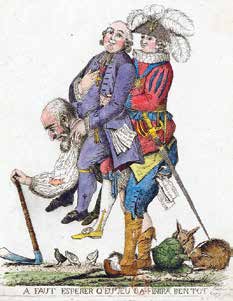The French Revolution was one of the greatest upheavals in European history. In just over ten years, the people of France destroyed and redesigned the country’s political structure, eliminating the absolute monarchy and feudal system that had dominated the population for centuries.
Although 1789 is recognized as the beginning of the Revolution, the causes reach back many decades. Through the second half of the 18th century, France was involved in a series of ruinously expensive wars including the French and Indian War, the Seven Years War, and the American Revolution. Financial management by the government was chaotic at best, and by 1788 the kingdom’s wealth had disappeared almost entirely. Additionally, two decades of poor harvests, cattle disease, and constantly rising bread prices spread deep misery throughout 98% of the population that was neither noble nor clergy. This great swath of the population— known as the Third Estate—lived in wretched destitution, their every action taxed to support the luxury and privilege of the nobility and the Church. Desperation and resentment ignited riots, looting, and striking throughout France.
Louis XVI, who was married to Marie Antoinette, ascended to the throne in 1774 at the age of twenty. Inspired by Enlightenment ideals, his early years were marked by attempts to improve the government; however, the nobility and Church strongly resisted these reforms—resulting in steadily worsening conditions for the commoners.
In 1786, Louis XVI’s financial minister proposed a universal land tax to which the privileged classes would no longer be exempt. This brought on a near-revolt by the aristocrats, and Louis was facing demands from all segments of the population. He summoned the Estates-General, a national convening of representatives of the Three Estates (nobles, clergy, and commoners), which had last occurred in 1614. Finding themselves in the vast majority, the Third Estate representatives mobilized to demand a new constitution that would guarantee equal representation (voting by head rather than by status) and eliminate the royal veto. They renamed the convening as the National Assembly, and vowed not to disband until a new constitution had been drafted. Begrudgingly, the King and other Estates were compelled to participate.

In a political cartoon of the day, clergy and nobility ride on the backs of the commoners.
While the National Assembly was meeting in Versailles, Paris was rocked by violence. There were rumors that the military would be sent to quell the popular insurgency in Paris, and on June 14th the people rioted. Insurgents stormed the Bastille fortress to take gunpowder and weapons to defend against the King’s army, an act that is celebrated as the beginning of the French Revolution.
The revolutionary spirit swept across the French countryside. Desperate, poor, and furious, the peasants revolted against years of exploitation and maltreatment, looting and burning the homes of tax collectors, nobles, landlords, and anyone seen as elite. During this agrarian insurrection, known as the Great Fear, nobles fled and sought asylum in neighboring countries. In August, 1789, the National Assembly moved to equalize taxation and end feudalism entirely, demolishing the system that had undergirded France’s political system for centuries.
Insurgents stormed the Bastille fortress to take gunpowder and weapons to defend against the King’s army, an act that is celebrated as the beginning of the French Revolution.
Over the next two years, the National Assembly reorganized governmental policies and structures. They approved the text of the Declaration of the Rights Of Man and of the Citizen as a statement of principle, nationalized all Church property, suppressed all religious orders, nullified nobility and titles, and abolished slavery in France (but not in French colonies). During this tumultuous time, the riots in Paris and the countryside continued, and the King made an unsuccessful attempt to flee to Austria.
In September 1791, France’s first written constitution was adopted. It reflected the more moderate views of the Girondists faction of the National Assembly, calling for a constitutional monarchy in which the King would retain veto powers and be able to appoint ministers. However, this centrist position inflamed the more radical Jacobins who rejected the constitution entirely. They wanted the monarchy to be utterly razed and replaced by a republican form of government. Influential radicals, including Maximillen de Robespierre, George Danton, and Jean-Paul Marat, began inflaming the populace and demanding that Louis XVI be tried for treason.
There was widespread fear that nobles who had fled to Austria and Prussia would call upon those countries to attack France to quell the Revolution. In response, the Assembly declared war on those two countries. They hoped not only to fend off the counterrevolutionary nobles, but also to spread the Revolution throughout Europe.
In Paris, the radical Jacobins arrested Louis XVI. The king and his family (including Marie Antoinette) were imprisoned for four months, during which the cascade of violence continued to overwhelm French life. The September Massacres saw the deaths of hundreds of accused counterrevolutionists in the streets of Paris. Simultaneously, legislation declared the end of the monarchy and the official establishment of the French Republic. King Louis XVI was sentenced to death for crimes against the state, and went to the guillotine on January 21, 1793—an act that earned the Revolution condemnation from countries around the world, and intensified the wars France was facing on all sides.
In the months following the King’s death, the Revolution entered its darkest, most dangerous phase: the Reign of Terror. The Jacobins seized control and crushed the moderate Girondists, labeling them counterrevolutionary and sending hundreds to the guillotine. Once those moderate voices were silenced, the Jacobins proceeded to eradicate Christianity, establish a new calendar, and launch the Committee of Public Safety. With Robespierre in charge, the Committee unleashed its rabid hunt for anyone who did not sufficiently support the Revolution. During his 10-month reign, Robespierre oversaw the trials and executions of over 17,000 people, while unknown numbers of others died in prison or without any official process.
Eventually, the people rose up against Robespierre in a coup d’etat known as the Thermidorian Reaction, and he suffered the same fate he had doled out to thousands—he met the guillotine on July 28, 1794. Following his death, the pendulum swung back to a more moderate phase lead by Girondists who had survived the Terror. In 1795, a new constitution was adopted that established a bicameral legislature for France, wherein a five-member directorate held executive power. Jacobin and Royalist opposition to this new form was swiftly put down by the army, lead by General Napoleon Bonaparte.
Sadly, the new government did not rise to the challenge of governing France. Political corruption was rife, systems were chaotic and inefficient, bread prices continued to rise, and the population again demanded change.
On November 9, 1799, Napoleon Bonaparte staged another coup and declared himself France’s ‘first consul’. The French Revolution was finished, superseded by the Napoleonic era.

